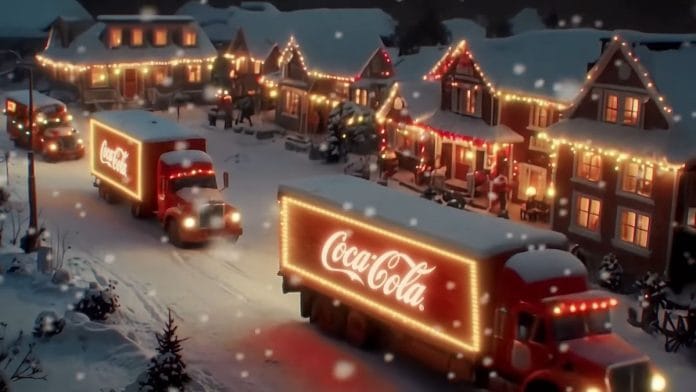Here’s a message for advertisers: stop relying on artificial intelligence for producing commercials. Sure, AI might simplify tasks and save money, but it fails to create a genuine connection with the audience. Coca-Cola’s latest AI-crafted ads, meant to honour the brand’s legendary 1995 “Holidays Are Coming” Christmas campaign, failed to deliver the festive magic and faced heavy backlash.
While AI-generated videos are gradually infiltrating the advertising world, brands are settling for visuals that only appear authentic at first glance.
In just six months, the public has rejected AI-driven advertisements not once, but twice. First, it was Toys”R”Us, and now Coca-Cola.
Lifeless and disconnected
Like the ’90s Christmas ad, the new, AI-generated version, released on 18 November, too, features red Coca-Cola delivery trucks decked out in Christmas lights.
The ad rushes through the shots so quickly that viewers barely have time to process what’s unfolding on the screen.
Instead of spreading Christmas cheer, the AI-generated commercial highlights the glaring flaws in current video generation models—failing to capture the joy, warmth, and festive spirit.
It feels hollow, lifeless, and disconnected.
In another Coca-Cola commercial, there are two shots of smiling customers, with Santa Claus handing a bottle of Coke to one of them. Not to forget the weird, thick fingers of Santa Claus.
Like, can it be more fake than this?
What stings fans even more is Coca-Cola’s decision to take the AI route, especially considering the brand’s long-standing connection with Christmas cheer.
While it’s a myth that Coca-Cola was behind making Santa’s suit red, the brand undeniably helped popularise the modern depiction of Santa Claus.
For many, this move feels like a betrayal of tradition.
Also read: Mentos is not saying ‘yes to fresh’. New campaign is a yawn
Real magic?
It’s important to understand that generative AI doesn’t truly “create”—it recycles and remixes past works.
The result is glitchy, uncanny imitations of human creativity.
Even if we put aside the emotional disconnect, the technical flaws in Coca-Cola’s AI-generated videos are glaring.
One of the ads juggle four settings—mountain town, NYC-style big city, small-town America, and a vintage aesthetic—none of which feel cohesive.
Then the unfinished billboards, half-lit ribbon bows, and a garbled illuminated sign.
While the conscious mind might overlook these details, the brain instinctively senses something is off.
The audience, in reality, is served with choppy visuals, clunky storytelling, and marketing that fails to resonate.
And the cherry on top? The videos concludes with the tagline “Coca-Cola… Real Magic”, after delivering what is arguably the fakest attempt at delivering festive cheer.
Also read: Flipkart’s new newspaper ad breaks mould of mundane print advertising, offers a ray of hope
India is far better
India stands out in leveraging AI for making advertisements. Here advertisers blend creativity, cultural insight, and AI in the form of technological innovation.
The diversity of India’s audience demands tailored messaging, and AI’s ability to process large datasets helps brands cater to regional preferences, languages, and purchasing habits with precision.
Cadbury India’s “Not Just a Cadbury ad” campaign, created by Ogilvy Mumbai, during Diwali 2021 is a prime example.
Using AI, Shah Rukh Khan’s message was personalised for countless small businesses, allowing them to replace generic ad content with tailored promotions featuring their shop’s name.
This not only brought tech-savvy personalisation to the forefront but also resonated deeply with audiences, combining a superstar’s charm with real-world impact.
Above all, the audience applauded the brand for the idea of bringing festive joy to small local vendors. The video clocked over 31 million views on YouTube.
“I am going to be a forever loyal customer. Kudos Cadbury!” read a comment. “Thank you cadbury india for this unique idea… sabki diwali acchi hona chahiye sirf E-commerce ka nahi.. love u saharukh,” another user wrote.
Magic of AI. Magic of Shah Rukh. Everything worked.
Another example is Zomato’s hyper-personalised notifications, driven by AI. Later, several brands followed suit.
By analysing user behavior, the food delivery giant sends witty, highly relevant notifications that make users feel directly addressed, boosting engagement.
India’s mastery lies in using AI as a creative collaborator rather than a mere tool.
By marrying technology with empathy, storytelling, and personalisation, Indian advertisements are not solely dependent on AI.
They are using it as a tool to enhance their creativity.
A lazy cut-copy-paste job using AI, like Coca-Cola’s attempt, wouldn’t do any favour to anyone.
Because, in the end, you also need some brains to use AI smartly.
Brand: Coca-Cola
AI studios: SecretLevel, Silverside AI, and The Wild Card
Marketing partner: WPP
Views are personal.






